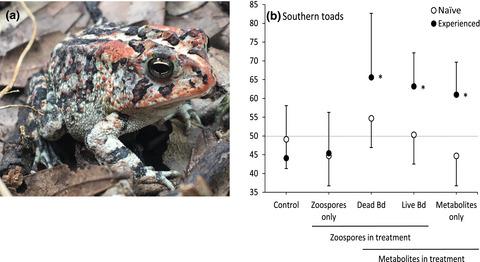当前位置:
X-MOL 学术
›
J. Appl. Ecol.
›
论文详情
Our official English website, www.x-mol.net, welcomes your
feedback! (Note: you will need to create a separate account there.)
Amphibian species vary in their learned avoidance response to the deadly fungal pathogen Batrachochytrium dendrobatidis
Journal of Applied Ecology ( IF 5.0 ) Pub Date : 2021-05-26 , DOI: 10.1111/1365-2664.13932 Taegan A. McMahon 1, 2 , Megan N. Hill 1 , Garrett C. Lentz 3, 4 , Electra F. Scott 1 , Nadia F. Tenouri 3, 4 , Jason R. Rohr 3, 5
中文翻译:

两栖动物对致命真菌病原体 Batrachochytrium dendrobatidis 的习得性回避反应各不相同
更新日期:2021-08-04
Journal of Applied Ecology ( IF 5.0 ) Pub Date : 2021-05-26 , DOI: 10.1111/1365-2664.13932 Taegan A. McMahon 1, 2 , Megan N. Hill 1 , Garrett C. Lentz 3, 4 , Electra F. Scott 1 , Nadia F. Tenouri 3, 4 , Jason R. Rohr 3, 5
Affiliation

|
- Lethal and sublethal effects of pathogens should theoretically select for host avoidance of these pathogenic organisms. Some amphibians can learn to avoid the pathogenic fungus Batrachochytrium dendrobatidis (Bd) after one infection-clearance event.
- Here, we investigated whether four taxonomically distinct amphibians, Cuban tree frogs Osteopilus septentrionalis, southern toads Anaxyrus (Bufo) terrestris, greenhouse frogs Eleutherodactylus planirostris and pine woods tree frogs Hyla femoralis, exhibited any innate or learned avoidance of Bd on a moist substrate and, if so, what cues they used to identify the fungus.
- Cuban tree frogs, pine woods tree frogs and greenhouse frogs did not appear to exhibit detectable innate or learned avoidance of Bd. However, southern toads learned to avoid Bd after only one exposure. Southern toads avoided any treatment containing Bd metabolites but did not avoid treatments that lacked Bd metabolites even when dead zoospores were present.
- Bd metabolites appeared to be the cues that amphibians use to avoid Bd. These metabolites may have a distinct smell or may cause discomfort, which would be consistent with a classical or Pavlovian conditioning response.
- Synthesis and applications. Not all species of amphibians respond the same way to Bd exposure; some can learn to avoid Bd and the metabolites it produces, while others do not. These findings have important implications for both management practices and policy, and should be considered when developing disease models and conservation plans for amphibians.
中文翻译:

两栖动物对致命真菌病原体 Batrachochytrium dendrobatidis 的习得性回避反应各不相同
- 理论上,病原体的致死和亚致死效应应选择宿主避免这些病原体生物。一些两栖动物可以在一次感染清除事件后学会避开致病真菌Batrachochytrium dendrobatidis (Bd)。
- 在这里,我们调查了四种分类学上不同的两栖动物,古巴树蛙Osteopilus septentrionalis、南方蟾蜍Anaxyrus ( Bufo ) terrestris、温室蛙Eleutherodactylus planirostris和松树林树蛙Hyla femoralis 是否表现出任何先天或后天避免对 Bd 和 Bd 的先天性或后天习得性。如果是这样,他们用什么线索来识别真菌。
- 古巴树蛙、松树林树蛙和温室蛙似乎没有表现出可检测到的先天或后天避免 Bd。然而,南方蟾蜍仅在一次接触后就学会了避免 Bd。南方蟾蜍避免任何含有 Bd 代谢物的处理,但即使存在死游动孢子,也不会避免缺乏 Bd 代谢物的处理。
- Bd 代谢物似乎是两栖动物用来避免 Bd 的线索。这些代谢物可能具有独特的气味或可能引起不适,这与经典或巴甫洛夫条件反射一致。
- 合成与应用。并非所有种类的两栖动物对 Bd 暴露的反应都相同。有些人可以学会避免 Bd 及其产生的代谢物,而其他人则不会。这些发现对管理实践和政策都具有重要意义,在为两栖动物制定疾病模型和保护计划时应予以考虑。











































 京公网安备 11010802027423号
京公网安备 11010802027423号